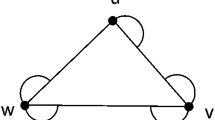Abstract
In this paper, we introduce certain types of fuzzy sets in a fuzzy graph including fuzzy dominating set, fuzzy minimal dominating set, fuzzy independent dominating set and fuzzy irredundant set. We describe these concepts with examples and develop the relationship between them. We also describe some interesting properties of fuzzy dominating set, fuzzy minimal dominating set, fuzzy independent dominating set and fuzzy irredundant set.









Similar content being viewed by others
Explore related subjects
Discover the latest articles, news and stories from top researchers in related subjects.References
Akram M (2011) Bipolar fuzzy graphs. Inf Sci 181:5548–5564
Akram M, Dudek WA (2011) Interval-valued fuzzy graphs. Comput Math Appl 61:289–299
Akram M, Davvaz B (2012) Strong intuitionistic fuzzy graphs. Filomat 26:177–196
Akram M, Dudek WA (2013) Intuitionistic fuzzy hypergraphs with applications. Inf Sci 218:182–193
Auer DB, Harary F, Nieminen J, Suffel CL (1983) Domination alteration sets in graphs. Discret Math 47:153–161
Bollobas B, Cockayne EJ (1979) Graph theoretic parameters concerning domination, independence and irredundance. J Graph Theory 3:241–250
Bhattacharya P (1987) Some remarks on fuzzy graphs. Pattern Recognit Lett 6:297–302
Bhutani KR, Moderson J, Rosenfeld A (2004) On degrees of end nodes and cut nodes in fuzzy graphs. Iran J Fuzzy Syst 1(1):57–64
Fulman J (1993) A note on the characterization of domination perfect graphs. J Graph Theory 17:47–51
Haynes T, Hedetniemi ST, Slater PJ (1998) Fundamentals of domination in graph. Marcel Deckker, New York
Kauffman A (1973) Introduction a la Theorie des Sous-emsembles Flous, Masson et Cie, vol 1
Mordeson JN, Peng CS (1994) Operations on fuzzy graphs. Inf Sci 79:159–170
Nagoorgani A, Chandrasekaran VT (2006) Domination in fuzzy graph. Adv Fuzzy Sets Syst 1(1):17–26
Nagoorgani A, Vadivel P (2007) Fuzzy independent dominating set. Adv Fuzzy Sets Syst 2(1):99–108
Nagoorgani A, Vadivel P (2009) Relations between the parameters of independent domination and irredundance in fuzzy graph. Int J Algorithms Comput Math 2(1):15–19
Nagoorgani A, Vijayalakshmi P (2011) Domination critical nodes in fuzzy graph. Int J Math Sci Engg Appl 5(1):295–301
Rashmanlou H, Pal M (2013) Antipodal interval-valued fuzzy graphs. Int J Appl Fuzzy Sets Artif Intell 3:107–130
Rashmanlou H, Jun YB (2013) Complete interval-valued fuzzy graphs. Ann of Fuzzy Math Inform 6(3):677–687
Rashmanlou H, Pal M (2013) Balanced interval-valued fuzzy graph. J Phys Sci 17:43–57
Rosenfeld A (1975) Fuzzy graphs. In: Zadeh LA, Fu KS, Shimura M (eds) Fuzzy sets and their applications. Academic Press, New York
Somasundaram A, Somasundaram S (1998) Domination in fuzzy graphs. Pattern Recognit Lett 19(9):787–791
Wang X, Wang Y, Xu XF, Ling W, Yeung D (2011) A new approach to fuzzy rule generation: fuzzy extension matrix. Fuzzy Sets Syst 123(3):291–306
Wang X, Hong J (1999) Learning optimization in simplifying fuzzy rules. Fuzzy Sets Syst 106(3):349–356
Xu W, Sun W, Liu Y, Zhang W (2013) Fuzzy rough set models over two universes. Int J Mach Learn Cybern 4(6):631–645
Yang X, Yang Y (2013) Independence of axiom sets on intuitionistic fuzzy rough approximation operators. Int J Mach Learn Cybern 4(5):505–513
Zadeh LA (1965) Fuzzy sets. Inf Control 8:338–353
Acknowledgments
The authors are highly thankful to Professor Xi-Zhao Wang, the editor in chief, and the reviewers for their valuable suggestions and comments.
Author information
Authors and Affiliations
Corresponding author
Rights and permissions
About this article
Cite this article
NagoorGani, A., Akram, M. & Vijayalakshmi, P. Certain types of fuzzy sets in a fuzzy graph. Int. J. Mach. Learn. & Cyber. 7, 573–579 (2016). https://doi.org/10.1007/s13042-014-0267-8
Received:
Accepted:
Published:
Issue Date:
DOI: https://doi.org/10.1007/s13042-014-0267-8




